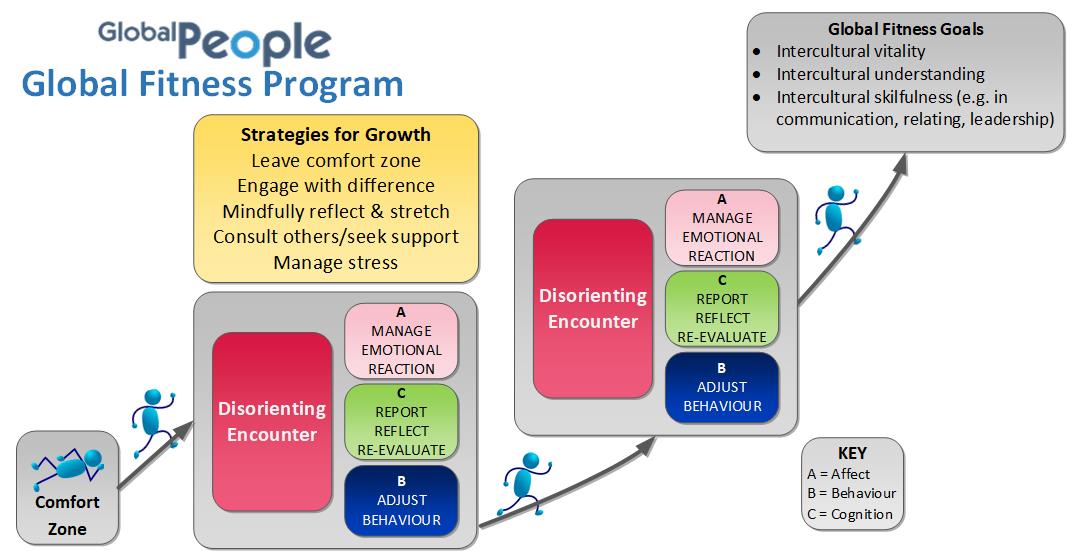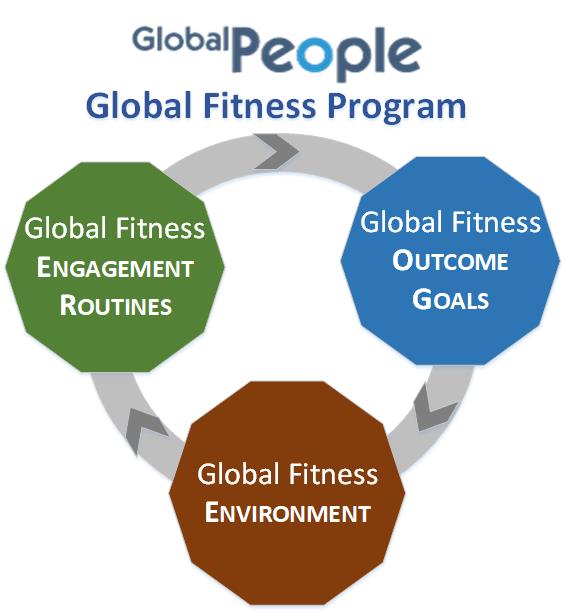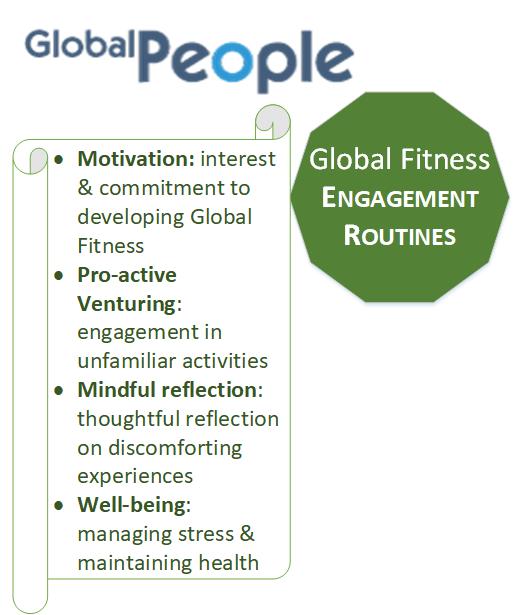What is global fitness?
Many different terms are used for the set of personal qualities and competencies that are needed for working effectively across cultural boundaries, including in a VUCA (volatile, uncertain, complex and ambiguous) world. They include:
|
|
|
Here at GlobalPeople, we have coined the term Global Fitness to capture the multifaceted nature of the personal qualities and competencies needed for working effectively across cultural boundaries. We provide some outline information below and in our webinars.
Building Global Fitness
How can people build their Global Fitness and develop the skills and qualities needed to function effectively in a globalising, VUCA (volatile, uncertain, complex, ambiguous) world?
Our Global Fitness Strength Cycle identifies three key facets:
- Global Fitness Environment
- Global Fitness Engagement Routines
- Global Fitness Outcome Goals
The development cycle is based on the principle of transformational learning, where three key elements are involved: the skills and attributes being fostered (Global Fitness Outcome Goals), the engagement of the individuals in taking steps to enhance their personal growth (Global Fitness Engagement Routines), and the support provided by the local environment to facilitate that growth (Global Fitness Environmental Affordances).
Global Fitness Environment
There are a number of elements in an individual's environment (e.g. workplace, university, local community) that are important for fostering or supporting global fitness. Three crucial ones are:
- Stretch opportunities: Out-of-the-comfort zone opportunities
- Guided support: Training and/or support to help people make the most of stretch opportunities
- Open community: Workplace or study cultural context that is open and receptive to difference
If organisations are serious in wanting to enhance the Global Fitness of their community, they need to ensure that they are providing these elements. Experiences of difference help stimulate growth, and so individuals need to be offered a range of out-of-the-comfort zone opportunities that will stretch them; for example, opportunities to work/study abroad or to work in teams with people from different backgrounds. Such opportunities can not only be exciting and challenging but also an important stimulant for growth. To a greater or lesser extent, such differences can cause mental and emotional challenges and it is this disequilibrium that stimulates growth (cf. Kim 2001)1.
However, individuals may not always understand or appreciate the differences they experience, and so they also need to have access to training and support that will help them reflect on and learn from their experiences. In addition, it is important that people around them (at work, at university, in the community) to be open and receptive to people with different backgrounds, and not ignore them or show prejudice towards them.
Global Fitness Engagement Routines
If individuals are to enhance their Global Fitness, they need to personally engage with the opportunities available to them. They need to take advantage of the affordances that their environment offers.
Firstly, this requires the motivation and commitment. Positive attitudes and strong motivation are always important: people need to be curious, open and interested in differences around them. In other words, they need a ‘spirit of adventure’ (The Intercultural Profiler, WorldWork). This helps them move out of their comfort zones and experience the differences that can stimulate their growth.
Secondly, they need to build development routines through engaging in the following:
- Pro-active Venturing: pro-active engagement in unfamiliar situations & enhancement activities
- Mindful reflection: thoughtful reflection on discomforting experiences
- Well-being: managing stress and maintaining health
The benefits of stretch opportunities are lost if people don’t engage with them. It is vital therefore that people seek out and take advantage of opportunities to move outside their comfort zones, venturing into unfamiliar territory. At the same time, they need to reflect on their experiences, noting differences and seeking insights. Help from trainers or cultural mediators can be invaluable here.
Such pro-active venturing can sometimes be challenging and uncomfortable. Traditionally this discomfort is known as culture shock and it is important that the stress is not so great that people withdraw. They need to maintain well-being – to understand the nature of culture shock and acquire suitable strategies for handling it. However, it is also important to remember that they should not be cushioned too much from difference, because growth requires a certain amount of stress. The stress needs to be handled through improved coping mechanisms, not simply removed.
The anthropologist Edward Hall (1976, p.46)2 has said “Most cross-cultural exploration begins with the annoyance of being lost.” This reiterates that the development of global fitness has an emotional aspect to it, but it also hints at another – the element of ‘being lost’. People are typically unsure how to behave in unfamiliar contexts, and so some learning is required. Sometimes it can be supposedly simple things like ways of greeting. Other aspects, such as adopting different turn-taking styles or levels of formality, can be even more challenging. For this, people need to be helped to observe carefully, to reflect on the differences they notice, and to have the opportunity to seek advice and explanation from someone with more insider understanding. Then they will be in a better position to make appropriate adjustments to their behaviour.
We refer to these three elements (pro-active venturing, mindful reflection, and well-being) as 'Development routines' to convey the notion of 'frequency' and 'regularity'. In other words, they need to become a 'normal' and 'regular' part of our lives if we are to build Global Fitness effectively.
The figure below represents this process diagrammatically.
Global Fitness Outcome Goals
The third element of the GlobalPeople Global Fitness Program is the outcome goals we want people to achieve. There are three main ones:
- Intercultural vitality: the personal qualities needed for functioning well in global contexts, e.g. resilience, self-awareness, adaptability, self-motivation
- Intercultural understanding: awareness of and sensitivity to own and others’ cultural values and beliefs, patterns of behaviour/ways of doing things, and systems, regulations etc.
- Intercultural skilfulness: competence in communicating smoothly & effectively across cultures, building relations and collaborating with people from different backgrounds, leading and working ethically & effectively in global contexts.
This threefold conceptualisation is a slight adjustment of our findings from the Global People eChina -UK project. For that, we identified four main clusters of intercultural competence: personal qualities, intercultural knowledge, intercultural communication skills, and rapport management skills. More details of these, including their sub-components and illustrative examples, can be found on our eChina-UK project webpages. In our global fitness program, we’ve combined the intercultural communication skills and rapport management skills into one cluster: Intercultural skilfulness.
Footnotes
1 Kim, Y. Y. (2001). Becoming Intercultural. An Integrative Theory of Communication and Cross-Cultural Adaptation. Thousand Oaks: Sage.
2 Hall, E. T. (1976). Beyond Culture. New York: Doubleday.
The Three Key Facets of the
Global Fitness Strength Cycle
Global Fitness Environment:
One of the three key facets of the
Global Fitness Strength Cycle
Global Fitness Engagement Routines:
One of the three key facets of the
Global Fitness Strength Cycle
Global Fitness Outcome Goals:
The skills and qualities being developed through the Global Fitness Strength Cycle




